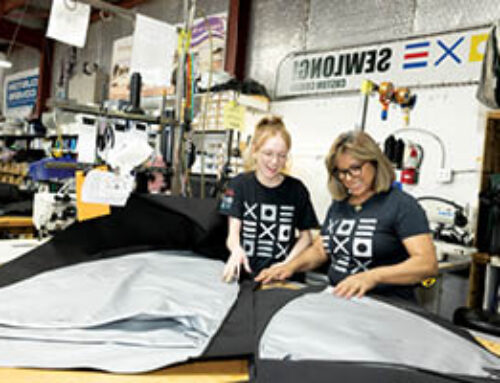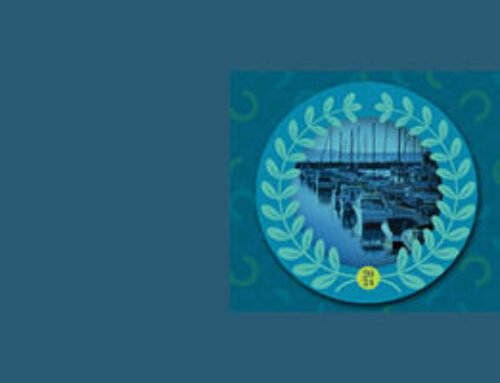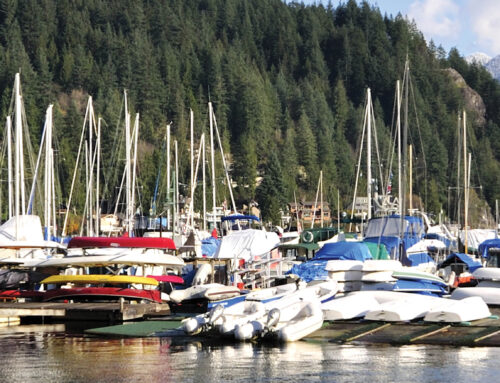Interior design trends 2017
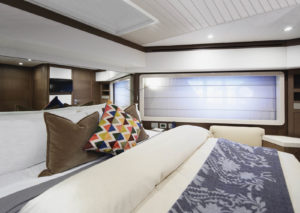
Neutrals still dominate, but customers are slowly embracing bolder patterns and colors that pop, especially on pillows, cushions and other soft furnishings.
Today’s interior designs of marine vessels represent a curious amalgam of styles and trends. This is a function of boat owners wanting to experiment with new looks as well as a willingness on the part of marine fabricators to take the lead in educating their clients about the broad range of options available. This balancing act means marine fabricators need to develop a design style that reflects a client’s desires, while also ensuring their suggestions make both visual and functional sense for the yacht or boat.
One of the biggest trends, says Krisha Plauché, owner of Onboard Interiors in Marblehead, Mass., is the use of more patterns in larger areas. Specializing in custom marine interiors for power and sailboats, Onboard Interiors is an award-winning interior design company serving New England boaters.
“Customers are really taking it slow, but they are finally warming up to the fun patterns available,” Plauché says. Plauché and her team at Onboard Interiors enjoy working with the Serge Ferrari One line of vinyl. “It is super soft and won’t pink,” Plauché says. “We also love to use the Ultraleather® Brisa® outdoor line because of its durability.”
Education is key
While some consumers may bring strong design ideas to the table, others may feel intimidated by the thought of hiring a marine fabricator to help them design or redesign their boat’s interior. They may worry about losing control of the design or budget, or feel anxious about not liking the finished space. Common questions for fabricators at the start of the design process include:
- Do you know what kind of flooring wears best in high-traffic areas?
- What’s an appropriate upholstery for an ottoman that will likely host both feet and snack trays?
- What’s the best lighting or flooring option for my boat?
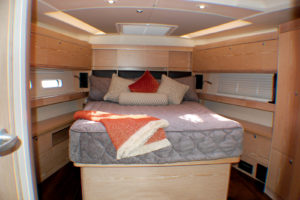
Onboard comfort goes a long way. Traditional fabrics look at home on boats, and fitted top quilts offer the durability and design boat owners desire. Sheet sets with matching coverlets are available in popular fabrics, blends, colors, prints and sizes—adding to the overall berth design.
Knowing the answers to these questions will reassure clients that working with a marine fabricator will not only save them time searching for the right products, but will also help them avoid costly mistakes.
Some fabricators learn about new marine trends from interior design trends within the residential or automotive market. Others turn to resources such as industry-specific magazines and design centers.
“Magazines are a wealth of information,” Plauché says. “We also visit local design centers. If we stay on trend with residential design, these trends will slowly trickle down to marine. And we have found that attending trade and boat shows and also the IFAI Marine Fabricators annual conference are great ways to learn about new techniques and tricks of the trade.”
Marine fabricators are schooled to look at the big picture, but they also need to look to customers for their ideas and visions for the interior of their boats. Plauché says it is vital to work closely with boat owners to determine their preferred design style.
“I will have a customer tear sheets from magazines and brochures. They will provide photos of their home or share items on Pinterest in order to [help me] better understand their taste and level of design,” Plauché says. “How basic or complex the interior design needs to be will then be obvious.”
Chris Costa, owner of Costa Marine Canvas in Egg Harbor City, N.J., gets his design ideas from both clients and different designers on the marine projects his company handles. He says he works with one designer, in particular, who specializes in marine interiors.
“He will introduce us to different ideas and trends. Sometimes a customer might come at us with a different design or idea,” Costa says. “Sometimes we will do a new design and it goes to a boat show and then it catches on real quick and dealers will start ordering boats with that design.” Costa says that designing for marine interiors is a unique skill. “I have found most interior designers who do residential work don’t translate into being good marine interior designers.”
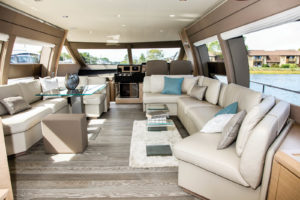
Cool neutrals and an emphasis on textures and layers from floor to ceiling give this interior a clean and modern look. New interior seating finishes include matte, pearlized and smaller modern patterns
and textures.
A move toward modern details
Costa Marine has a long association with Viking Yachts and has been providing complete interior and exterior outfitting for more than 40 years. Costa says that interior wood finishes are moving away from traditional high-gloss teak and trending toward a more modern looking walnut with satin finishes. Likewise, interior sofas have been trending toward modern square corner boxed-style cushion design with removable cushions.
“When you remove the backs, this allows more area to sleep on sofas, which is especially nice when the yacht is on long runs to distant fishing grounds,” Costa says. “The square inside corners of the sofa, in lieu of radius, allow a person to tuck into a corner when the boat is running, whereas the old traditional radius corners weren’t comfortable for that. This ‘square’ design is becoming common in our market, but already has been common in the European market.”
On any size boat or yacht, storage is paramount. As such, all of Costa Marine’s sofas and dinettes are built with storage underneath.
“All of our sofas are equipped with gas springs, which assist the opening of the sofa seats and backs,” Costa says. “We did a project last year on a 92-foot Viking where the customer had us fabricate a sofa with electric actuators to lift the sofa seats. He pushed a button and all his sofa seats lifted.”
Durability is still key for marine applications, but with some modern twists. Pam Erickson at Canvas Designers® in Riviera Beach, Fla., says her company has found that the Sunbrella® Sling fabric is great for exterior cushions.
“It’s durable, as we all know Sunbrella is, with the blend of the polyester and PVC mesh making it durable and highly breathable,” Erickson says. Canvas Designers tends to do a lot of refits.
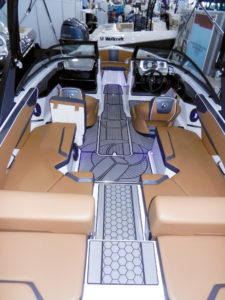
Featured in the 2016 Miami Boat Show, the interior of this 2017 Scarab is an excellent example of a warm/cool interior. Featuring a clean white base, as well as cognac and graphite vinyl upholstery from Spradling, this boat boasts a clean, yet inviting interior.
Photo Credit: Spradling.
“Our customers purchase used boats and want to make them their own,” Erickson says. “This season, adjustable bow cushions and quilted inserts on exterior and interior cushions and furniture are very popular. The key style is modern, clean and crisp, which means squared and boxed cushions and sofas. Grays, tans and other natural tones seem to be popular with hints of color that pop, such as on pillows.”
Darrell Brown, sales and soft furnishings program manager at Oceanair Marine in Bradenton, Fla., is seeing less focus on color and pattern, but more on texturing and layering.
“The basic production OEM [original equipment manufacturer] marine interiors are becoming more modern with cleaner lines,” Brown says. “There has been a surge in chenille fabric but with a lower nape and a more modern appearance. Right now, Ultraleather is the leading supplier in interior seating applications, but I am seeing less interest in the distressed look and more emphasis on newer finishes like matte, pearlized and smaller modern patterns and textures.
“It gives a more ‘high-end superyacht’ feel to the smaller production vessels,” Brown says. “With Crypton® finish, you can make most fabrics work in these type of applications. Customization is all about the details. Stitching is a huge component and also the seat design is more critical now than in the past. Manufacturers are now realizing the true value of good design.”
Helping clients get it right
Providing interior design suggestions, based on new trends, is valuable to clients. However, Plauché says she also helps her customers make selections by embracing the adage, “Beauty is in the eye of the beholder.”
“That adage is so true,” Plauché says. “What a designer might like might not be what a customer wants at all. We need to listen to what they want and then formulate a plan for them.”
Onboard Interiors uses design boards in its showroom to understand how a customer reacts to colors and textures.

Stylish and spare, newer interior materials emphasize a sleek, minimalistic design sensibility. This neutral interior provides a calming respite with accent pillows adding a hint of color.
“One customer recently told us her young grandchildren like ocean themes, so we found a fun lobster print to use on her pillows,” Plauché says. “Another customer told us he used a lot of home furnishings from Roche Bobois, so we knew he liked sleek, minimalistic design. We can incorporate some of the trends only when a customer is ready for them.”
Costa says he has clients who walk in and say, “I saw this on a Viking yacht interior you did and love it. I want the same.”
“We will have clients wanting to do a complete renovation, but they want to keep the sofa or a particular piece the same because they don’t want to spend money on that piece because it’s still in good shape,” Costa says. “Then we are trying to coordinate everything else with that particular piece. Sometimes this works and sometimes not. On a refurbish job, I like to start from scratch, which is normally what most clients tend to go with.”
When working with clients on marine interiors, Brown says Oceanair Marine’s job is to show them the new trends, but more importantly, to help them coordinate all of the materials from flooring to countertops, cabinet colors and details.
“Only once you have these items can you really dial in the colors and bedding products to enhance these ideals,” Brown says. “We have always seen a trend to more neutral palettes, which does give you that calm respite. Also, there is resale awareness and a faster pace in design trends, which a neutral interior can adapt to easier. You can change accents in pillows and bedding to accomplish this task. The concern I have is sometimes the manufacturers don’t want to jump too far ahead of the curve and will pull back to a more conservative approach in interior design.”
Maura Keller is a freelance writer from Plymouth, Minn.
 TEXTILES.ORG
TEXTILES.ORG 


